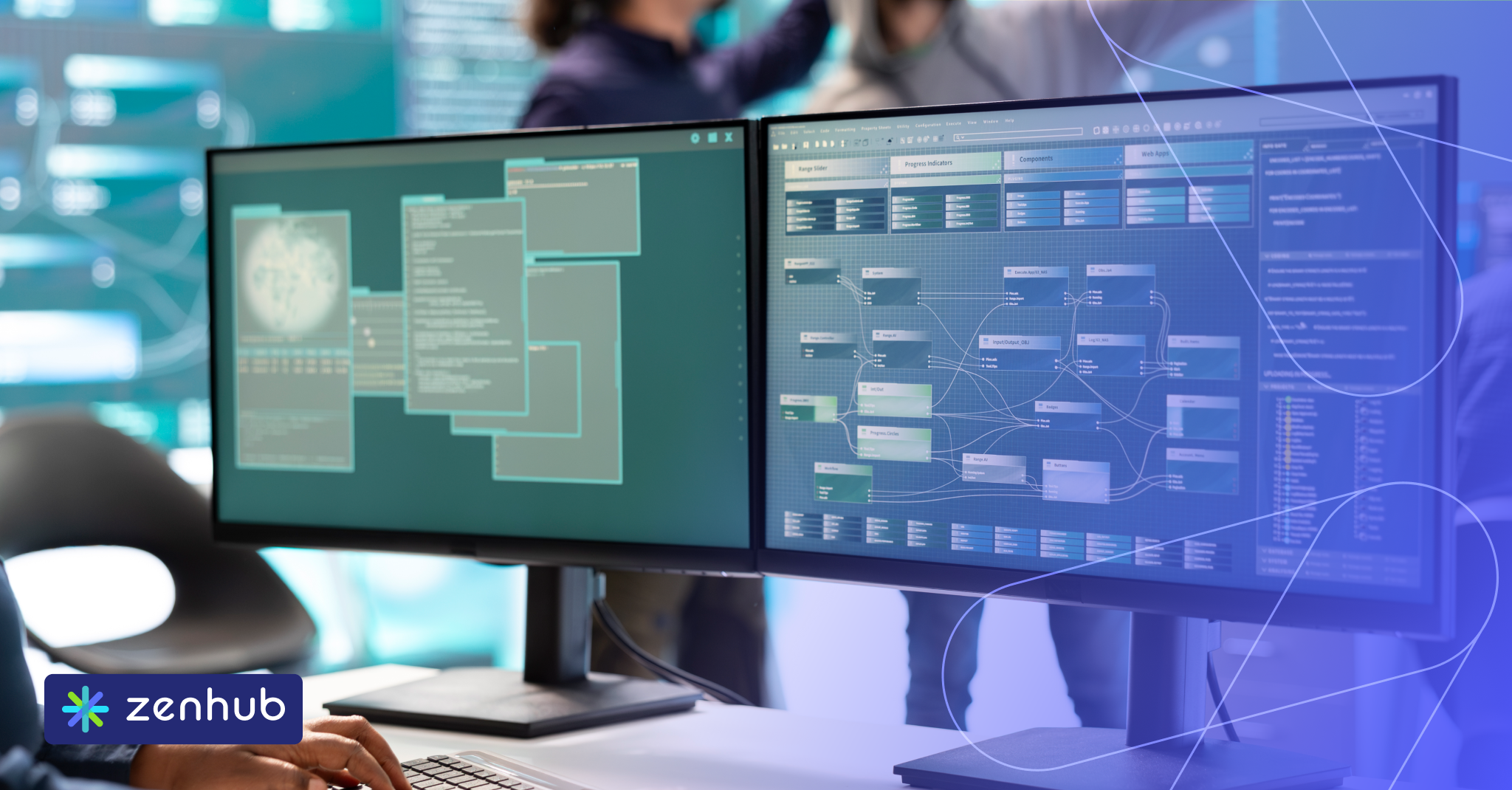Browse topics
The Definitive Guide to AI Project Management for Agile Practitioners
AI project management integrates machine learning, NLP, and automation into Agile workflows to automate routine tasks, provide predictive insights, and optimize planning, resourcing, and delivery while preserving Agile collaboration and continuous improvement.
What Is AI Project Management and How It Works in Agile
AI project management is the application of AI technologies—machine learning, natural language processing, and automation—to core project management activities within Agile frameworks. It enhances sprint planning, backlog management, workflow optimization, and team collaboration by turning historical and real-time data into actionable recommendations.
Instead of relying solely on human intuition and manual processes, AI analyzes project history, team performance metrics, and workflow patterns to surface risks, predict outcomes, and suggest optimizations. Typical capabilities include automated backlog grooming, intelligent sprint reviews, predictive analytics for delivery timelines, and feedback automation that consolidates stakeholder input. For example, AI can automate feedback collection and use predictive analytics to improve sprint outcomes.
In practice, AI manifests as:
- Intelligent automation of repetitive tasks (status updates, ticket triage)
- Real-time risk assessment and alerts
- Dynamic resource allocation based on capacity and skills
- Data-driven insights for retrospectives and planning
These features free teams to concentrate on high-value work—design, problem-solving, and stakeholder engagement—while maintaining Agile’s iterative, collaborative nature.
Key Benefits of AI in Agile Project Management
AI integration delivers measurable benefits by processing large datasets quickly and converting them into practical insights.
Enhanced Decision-Making
- AI algorithms analyze diverse datasets to recommend priorities, resource allocations, and risk mitigations, reducing guesswork and improving planning accuracy (source).
Increased Efficiency
- Automation of repetitive tasks—status updates, progress tracking, test case generation—frees time for creative and strategic work (source).
Improved Collaboration
- AI-powered communication tools enable real-time updates and coordination for distributed teams, improving alignment and reducing friction (source).
Other notable benefits:
- Faster, more accurate story point estimation
- Automated backlog prioritization
- Data-driven Agile rituals and real-time analytics
- Proactive risk identification and mitigation
- Better predictability of delivery timelines and resource needs
Differences Between AI Project Management and Traditional Methods
The practical differences are visible in information gathering, decision-making cadence, and adaptability.
Traditional approaches depend on scheduled check-ins, manual reporting, and post-facto adjustments. AI enables continuous monitoring, earlier risk identification, and automated optimization, shifting teams from reactive to proactive management and enabling earlier interventions to prevent sprint failures (source).
How to Implement AI Project Management Effectively
Implement AI incrementally, aligning with Agile principles: iterate, learn, and expand. A phased, pragmatic approach reduces disruption and builds organizational confidence.
Core prerequisites:
- Leadership support and stakeholder buy-in
- Clear change-management strategy
- Training and documentation for teams
A recommended implementation roadmap:
- Assess current workflows and identify automation opportunities
- Evaluate and select tools based on needs and systems compatibility
- Pilot with a subset of projects or sprints
- Prepare and integrate data across systems
- Train teams and build skills
- Expand AI capabilities gradually
- Monitor outcomes and refine processes continuously
Focus on measurable wins early—reducing manual work, improving estimation accuracy, or shortening cycle times—to justify broader adoption and maintain momentum.
Selecting the Right AI Tools for Agile Teams
Tool selection depends on team size, technical maturity, workflow complexity, and integration requirements.
Common options:
- Jira: Customizable Agile planning, tracking, and release management for enterprise needs.
- GitHub: Native version control with collaborative features that link code and project workflows.
- Asana: User-friendly task tracking for cross-functional teams and non-code projects.
- Trello: Simple board-and-card interface ideal for small teams or lightweight projects.
- MLflow: Lifecycle management for machine learning models and AI workflows.
Consider integration with existing systems, scalability, learning curve, and total cost of ownership (training and maintenance). For software teams wanting minimal context switching, Zenhub integrates AI insights directly within GitHub and offers enterprise-grade security.
Setting Clear Goals and Metrics for AI Integration
Define specific, measurable goals tied to business value so AI investments yield provable returns. Examples:
- Decrease backlog cycle time by 20%
- Reduce manual reporting hours by 40%
- Improve sprint completion rates by 15%
KPIs to track:
- Sprint completion rates and velocity consistency
- Reduction in manual interventions
- Prediction accuracy for delivery timelines
- Time to release and deployment frequency
- Team engagement and stakeholder satisfaction scores
Clear goals facilitate cross-functional buy-in and help prioritize AI-driven improvements that align with organizational objectives.
Fostering Cross-Functional Collaboration and Data Sharing
AI success depends on breaking down silos between business and technical teams and creating robust data flows.
Key practices:
- Combine synchronous rituals (standups, planning, retrospectives) with asynchronous channels (dashboards, automated reports, shared docs)
- Define data access, quality standards, and privacy controls
- Implement shared analytics dashboards and regular cross-team knowledge sessions
- Provide training on interpreting and acting on AI insights
AI tools improve distributed collaboration and compliance when teams adopt clear governance and cultural openness to data sharing (source).
Automating Routine Tasks and Enhancing Sprint Planning
Automation targets repetitive, high-frequency tasks so teams spend time on strategic work.
Common automation targets:
- Backlog updates and triage
- Sprint planning assistance and story point estimation
- Test case generation and regression testing
- Feedback collection and analysis
Implementation steps:
- Identify routine tasks via workflow analysis
- Map tool integration points
- Pilot automation on low-risk, high-frequency tasks
- Iterate using real-time data to refine rules
AI improves sprint planning by offering intelligent story point estimation, capacity planning based on historical performance, and risk assessments for proposed sprint goals, reducing planning time and increasing forecast accuracy (source).
Continuous Learning and Process Improvement with AI Insights
AI enhances continuous improvement by surfacing patterns and root causes that manual review may miss.
Capabilities include:
- Automated retrospectives using aggregated data
- Bottleneck and recurring-issue detection
- Sentiment analysis for team morale and engagement
- Predictive models to anticipate future problems
- Automated suggestions drawn from successful patterns across projects
Incorporate AI insights into Agile rituals: use them to guide retrospectives, inform sprint planning, and measure the impact of process changes. This creates a virtuous loop where AI-driven improvements generate better data for future analysis (source).
The Evolution of AI Project Management in 2025 and Beyond
By 2025 AI will be deeply embedded in Agile workflows, extending from automation of routine tasks to strategic decision support. Expect advances in predictive accuracy, hyperautomation, real-time risk management, and human–AI collaboration.
Trends to watch:
- Advanced predictive analytics forecasting project outcomes more accurately
- Hyperautomation that automates multi-step processes and routine decision-making
- Real-time risk management with continuous monitoring and suggested interventions
- Adaptive planning that adjusts scope and timelines dynamically
- Collaborative intelligence augmenting—not replacing—human decision-making
- Increased AI-driven compliance tools to meet regulatory needs without slowing delivery
These developments will enable faster response to market changes, tighter alignment between strategy and delivery, and improved organizational resilience.
Predictive Analytics and Real-Time Adaptive Workflows
Predictive analytics combines historical and live data to forecast trends, risks, and outcomes. Modern AI can model scenarios across projects and teams to reveal likely impacts of different decisions.
Use cases:
- Early risk identification and mitigation
- Dynamic sprint scope adjustments based on real-time progress
- Scenario modeling for tradeoffs between feature scope, timeline, and resources
Real-time adaptive workflows let AI continuously monitor progress and recommend immediate actions—adjusting sprint goals, flagging bottlenecks, or reallocating work—transforming Agile from periodic adaptation to continuous optimization (source).
Intelligent Resource Optimization and Risk Mitigation
AI enhances resource planning by factoring in skills, capacity, workload balance, and development goals, not just availability.
Intelligent risk mitigation continuously scans project data, communications, and external factors to surface emerging risks and propose mitigations, often presented via real-time dashboards for rapid action (source).
AI-Driven Reporting, Transparency, and Decision Support
AI automates reporting and makes project data more transparent and actionable.
Features:
- Real-time dashboards and automated report generation
- Interactive analytics for stakeholders
- Decision support systems that analyze data, market signals, and constraints to recommend actions
These tools improve accountability, enable objective sprint reviews, and support faster, data-backed strategic choices (source).
Preparing Agile Teams for the AI-Enabled Future
Preparation requires both technical skill-building and cultural change.
Essential strategies:
- Cultivate an adaptive mindset that values continuous improvement
- Build AI literacy—predictive analytics, automation basics, and ethics
- Develop change resilience via iterative pilots and open feedback
- Keep a human-centered focus: use AI to augment judgment, not replace it
Training should cover how AI models work, how to interpret outputs, and when to override recommendations. Leadership must communicate limits and benefits clearly, fund training, and create a safe environment for experimentation and learning.
Frequently Asked Questions
How Does AI Enhance Agile Project Management?
AI automates repetitive tasks, provides predictive insights, and enables data-driven decisions that reduce bottlenecks and improve estimation and delivery accuracy. It shifts teams from reactive to proactive management.
What Key AI Tools Should Agile Practitioners Use?
Choose tools that integrate with existing workflows: Jira for enterprise Agile, GitHub for code-centric teams, Asana for cross-functional task tracking, Trello for simple visual workflows, MLflow for ML lifecycle, and Zenhub for GitHub-native AI insights.
How Does AI Impact the Role of Agile Practitioners?
AI augments Agile practitioners by removing routine work and delivering analytics that support strategic decisions, allowing teams to focus on stakeholder engagement, innovation, and continuous improvement.
What Skills Are Needed to Integrate AI in Agile Workflows?
Teams need data literacy, familiarity with AI fundamentals and automation tools, competence in configuring and monitoring AI systems, and strong communication and change-management skills.
How Can AI Improve Scrum and Kanban Methodologies?
AI streamlines Scrum and Kanban by enhancing estimation, automating backlog grooming and prioritization, surfacing bottlenecks, and providing predictive insights that enable faster, more accurate adaptations.

%202.svg)













